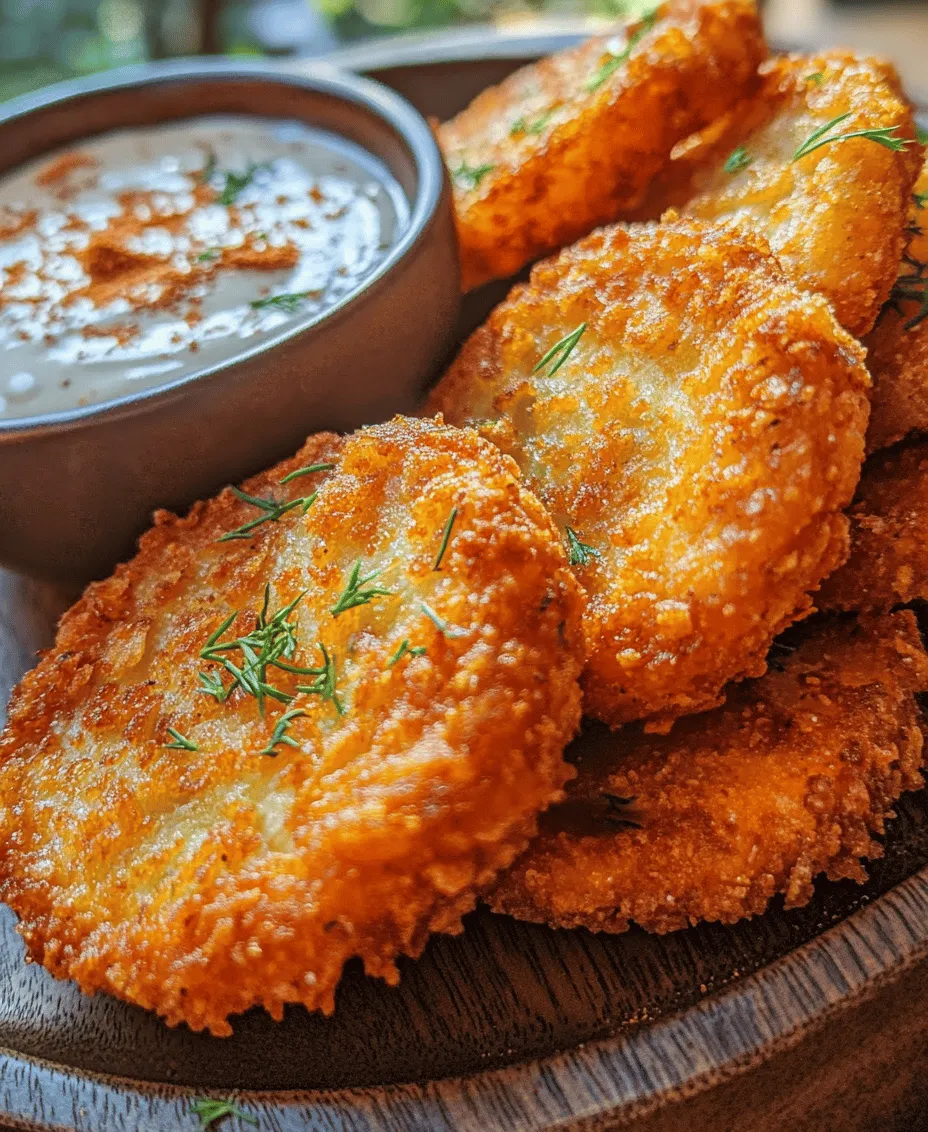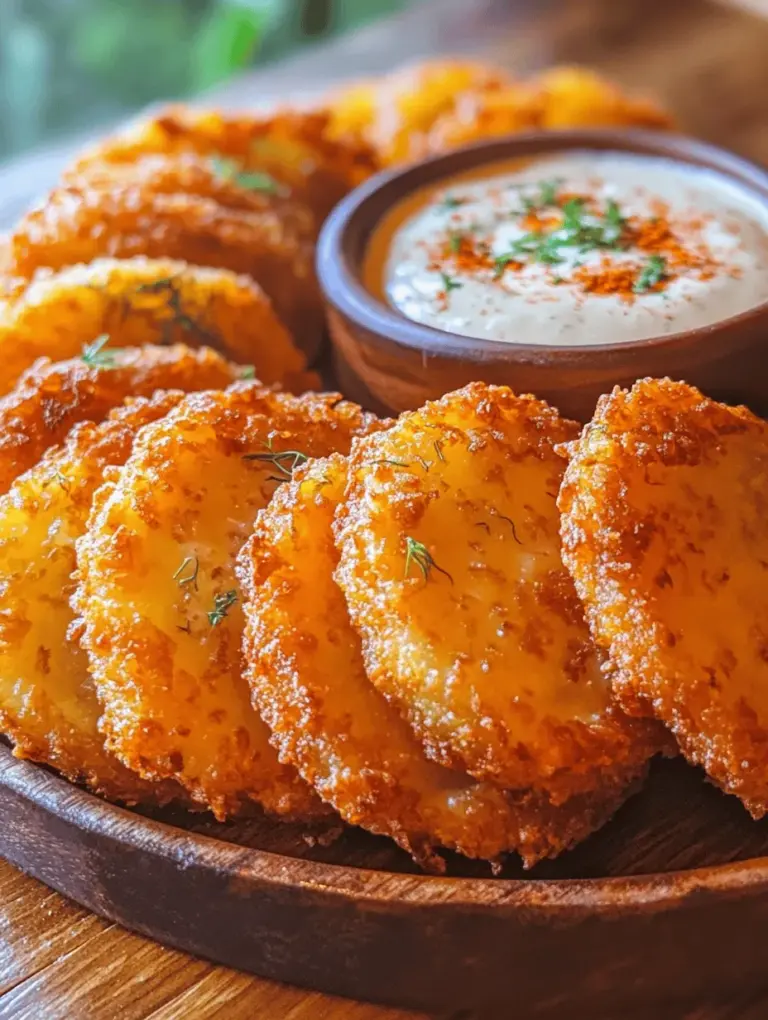Introduction
Fried pickles have become a beloved snack and appetizer across the United States, captivating taste buds with their irresistible crunch and tangy flavor. This Southern delicacy has made its way onto menus in restaurants and bars, delighting patrons with its unique combination of salty and sour, all wrapped up in a crispy coating. While you can certainly find fried pickles in many dining establishments, there’s something special about making them at home. Homemade fried pickles are not only customizable to your taste but also allow for a fresh, satisfying experience that can’t be replicated. Whether you prefer them spicy, extra crispy, or seasoned just right, preparing this dish in your own kitchen promises enjoyment for both the cook and the diners.
In this article, we’ll take you through the delightful process of creating crunchy fried pickles. You’ll discover the simplicity of the recipe, the ingredients that elevate its flavor, and detailed instructions for achieving that perfect crunch. So, roll up your sleeves, and let’s dive into the delicious world of fried pickles!
The Allure of Fried Pickles
Fried pickles have their roots deeply embedded in Southern cuisine, with historical accounts suggesting that they were first popularized in the early 1960s. The exact origin is often debated, but many credit the small town of Atkins, Arkansas, where a local diner began serving them as a unique appetizer. Since then, fried pickles have exploded in popularity, becoming a staple in bars, restaurants, and at backyard cookouts across the country.
Their appeal lies not only in their flavor but also in their versatility. Fried pickles serve as a fantastic finger food, making them an ideal choice for parties, game days, or casual gatherings. They can be served with an array of dipping sauces, ranging from classic ranch to spicy sriracha mayo, allowing you to tailor the experience to your liking. Moreover, fried pickles can be enjoyed as a side dish alongside burgers or sandwiches, or even as a stand-alone snack that’s perfect for sharing.
Ingredient Breakdown
To achieve the ultimate crunchy fried pickles, it’s essential to understand the role of each ingredient in the recipe. Here’s a breakdown of what you’ll need:
Dill Pickle Slices or Spears
At the heart of this dish are the dill pickles themselves. For this recipe, dill pickles are the best choice due to their sharp, tangy flavor that pairs beautifully with the crispy coating. You can use either slices or spears, depending on your preference. Slices are perfect for dipping, while spears offer a fun way to enjoy the crunch. Regardless of your choice, make sure to use pickles that are well-brined to ensure they deliver that signature flavor.
All-Purpose Flour and Cornmeal
The combination of all-purpose flour and cornmeal plays a crucial role in creating that desired crunch. All-purpose flour provides the base for the batter, helping it adhere to the pickles, while cornmeal adds texture and a distinct corn flavor that elevates the overall taste. This combination ensures that the coating is not only crispy but also flavorful.
Spices and Seasonings
When it comes to spices and seasonings, the right blend can make all the difference. Here’s a closer look at the key players:
– Garlic Powder and Onion Powder: These two staples add a savory depth to the batter, enhancing the overall flavor profile of the fried pickles.
– Paprika: This spice not only contributes a beautiful color but also adds a mild sweetness that complements the tanginess of the pickles.
– Cayenne Pepper: For those who enjoy a bit of heat, cayenne pepper allows you to adjust the spice level to your personal preference. A little goes a long way, so feel free to add more or less depending on your taste.
– Salt and Black Pepper: These essential seasonings enhance the overall taste and bring all the flavors together, ensuring that each bite is delicious.
Buttermilk
Buttermilk is a key ingredient in this recipe, serving multiple purposes. It adds moisture to the batter, creating a lovely creamy texture that helps the flour and cornmeal adhere to the pickles. Additionally, buttermilk brings a slight tanginess that complements the flavors of the fried pickles, making them even more irresistible. If you don’t have buttermilk on hand, you can easily make a substitute by mixing milk with a splash of vinegar or lemon juice.
Vegetable Oil
Finally, we have vegetable oil, which is essential for frying. The type of oil you choose can impact the flavor and healthiness of your fried pickles. Oils with a high smoke point, such as canola oil or peanut oil, are ideal for frying as they can withstand the high temperatures required without burning. It’s crucial to monitor the oil temperature during frying, as maintaining the right heat ensures that the pickles cook evenly and achieve that perfect golden brown color.
Preparing the Fried Pickles
Now that we’ve covered the ingredients, it’s time to prepare the fried pickles. Follow these step-by-step instructions to ensure that your pickles turn out perfectly crispy and delicious.
Step 1: Drain and Dry the Pickles
The first step in preparing your fried pickles is to drain them thoroughly. Excess moisture can lead to a soggy coating, so it’s essential to rid your pickles of any brine. Place the pickle slices or spears in a colander and let them drain for about 10-15 minutes. After draining, use paper towels to pat them dry. This extra step ensures that the coating adheres properly and promotes that desired crunch.
Step 2: Set Up a Breading Station
Creating an efficient breading station will make the process smoother. Start by gathering three shallow dishes or plates. In the first dish, add the all-purpose flour mixed with a pinch of salt and black pepper. In the second dish, pour in the buttermilk, and in the third dish, combine the cornmeal with garlic powder, onion powder, paprika, cayenne pepper, and any additional seasonings you prefer. Having everything organized will help you bread the pickles quickly and uniformly.
Step 3: Breading Process
Now, let’s move on to the breading process. Begin by taking a dried pickle slice or spear and dip it into the flour mixture. Make sure to coat it evenly, shaking off any excess flour. Next, transfer the coated pickle to the buttermilk, ensuring it’s fully submerged. Allow any excess buttermilk to drip off before moving it to the cornmeal mixture. In the cornmeal dish, press the pickle gently to ensure an even coating. This step is crucial for achieving that crispy outer layer.
Repeat this process for all the pickle slices or spears, arranging them on a plate or baking sheet once breaded. If you find that some pickles need an extra layer of coating, feel free to dip them back into the buttermilk and then into the cornmeal again for an even thicker crust.
As you prepare your fried pickles, it’s important to keep an eye on your frying oil. Preheat the vegetable oil in a deep skillet or a pot over medium heat until it reaches about 350°F (175°C). You can test the oil temperature by dropping a small piece of bread into the oil; if it bubbles and sizzles, it’s ready for frying.
With your pickles breaded and oil heated, you are well on your way to enjoying this crunchy, flavorful treat. In the next part of this article, we will cover the frying process and tips to make sure your fried pickles turn out perfectly crispy. Stay tuned!

Tips for Handling the Pickles During Breading
When preparing crunchy fried pickles, the breading process is crucial for achieving that signature crispy texture. Here are some helpful tips to handle the pickles effectively and reduce the risk of breaking them during the breading process:
1. Pat Dry: Start by patting the pickles dry with paper towels. Excess moisture can lead to a soggy coating and make the pickles more difficult to bread without breaking.
2. Use a Fork or Tongs: Instead of using your fingers, which can create moisture and make handling slippery, use a fork or tongs to pick up the pickles. This will help maintain their shape during the breading process.
3. Coat Lightly: When dipping the pickles into the egg wash and then into the breading mixture, do so gently. Ensure that each pickle is evenly coated, but avoid pressing too hard, which can break them.
4. Chill Before Frying: After breading, place the pickles on a parchment-lined baking sheet and chill them in the refrigerator for about 15-30 minutes. This helps set the breading and reduces the chances of it falling off during frying.
Frying Process
Frying is where the magic happens, transforming your breaded pickles into a crunchy delight. Here’s how to execute the frying process perfectly:
Importance of Oil Temperature and How to Achieve It
The right oil temperature is essential for achieving that perfect crunch. If the oil is too cool, the pickles will absorb too much oil and become greasy. Conversely, if the oil is too hot, the outside may burn before the inside is cooked.
– Ideal Temperature: Aim for an oil temperature between 350°F to 375°F (175°C to 190°C). This is the sweet spot for frying pickles to ensure they are crispy and golden brown.
– Using a Thermometer: For the best results, use a deep-fry thermometer to monitor the oil temperature. Make sure to preheat the oil in a deep, heavy pot or skillet over medium-high heat before adding the pickles.
Explanation of the Sizzle Test for Oil Readiness
A simple way to check if your oil is ready is the sizzle test:
– Dropping a Small Amount of Batter: Before frying all the pickles, drop a small amount of the breading mixture into the oil. If it sizzles and bubbles immediately, your oil is ready for frying. If it sinks to the bottom and does not bubble, the oil is not hot enough.
Tips for Frying in Batches to Maintain Oil Temperature
Frying in batches is crucial to maintain the oil temperature and ensure even cooking:
– Don’t Overcrowd the Pan: Frying too many pickles at once can lower the oil temperature significantly. It’s better to fry in small batches, leaving enough space between each pickle for even cooking and browning.
– Adjusting Heat: After each batch, allow the oil to return to the desired temperature before adding more pickles. This will ensure that they fry properly and evenly.
Visual Cues to Look for When the Pickles are Perfectly Fried
The ultimate goal is to achieve that beautiful golden brown color. Here’s what to look for:
– Color: The pickles should turn a deep golden brown while frying, indicating they are crispy and done.
– Bubbling: The oil should continuously bubble around the pickles, suggesting they are frying correctly.
– Time: Typically, it takes about 2-3 minutes per batch for the pickles to fry to perfection, but keep an eye on them to prevent burning.
Serving Suggestions
After the frying process, it’s time to serve your crunchy fried pickles in style:
How to Properly Drain the Fried Pickles for Maximum Crunch
Once the pickles are golden brown and crispy, it’s important to drain them properly to maintain that crunch:
– Using a Wire Rack: Transfer the fried pickles to a wire rack set over a baking sheet. This allows excess oil to drip off while preventing the pickles from becoming soggy.
– Paper Towels: If you don’t have a wire rack, placing the pickles on a plate lined with paper towels can also work, but remember to flip them halfway to ensure even draining.
Various Dipping Sauce Options
No fried pickle experience is complete without the perfect dipping sauce. Here are some delicious options:
– Classic Ranch Dressing: A favorite for many, ranch dressing pairs perfectly with fried pickles. For an added kick, mix in a few drops of hot sauce to create a spicy ranch.
– Spicy Mayo: Combine mayonnaise with Sriracha or your favorite hot sauce for a creamy and spicy dip that complements the crunchiness of the pickles.
– Garlic Aioli: A garlic aioli offers a rich and flavorful option. Simply mix mayonnaise with minced garlic, lemon juice, and a pinch of salt.
Ideas for Serving: Platter Arrangements for Gatherings or Parties
Presentation can elevate your dish, especially for gatherings:
– Platter Arrangement: Arrange the fried pickles on a large serving platter, garnishing with fresh parsley or dill for a pop of color.
– Dipping Stations: Place small bowls of different dipping sauces around the platter for guests to choose from.
– Accompaniments: Consider serving alongside other appetizers, like onion rings, mozzarella sticks, or a veggie platter, to create a delightful appetizer spread.
Nutritional Information
Understanding the nutritional aspects of your fried pickles can help make informed choices:
Overview of the Nutritional Aspects of the Dish
Fried pickles are a delicious treat but should be enjoyed in moderation:
– Serving Size: A standard serving size of fried pickles is about 1 cup (approximately 6-8 pickles).
– Calories: On average, fried pickles contain about 300-400 calories per serving, depending on the coating and cooking method.
Discussion on the Healthiness of Fried Foods and Moderation
While fried pickles are undeniably tasty, they are a fried food and should be enjoyed as an occasional indulgence:
– Balance: Pairing them with lighter, healthier options in your meal can help balance your overall dietary intake.
– Alternatives: Consider baking or air frying pickles for a lower-calorie alternative if you are looking to enjoy them more regularly.
Variations on the Recipe
One of the joys of cooking is experimenting with different ingredients and flavors. Here are some creative variations on the classic crunchy fried pickles recipe:
Exploring Alternative Ingredients
– Different Types of Pickles: Instead of standard dill pickles, try using sweet pickles, spicy pickles, or even pickle spears for a twist on the traditional flavor profile.
– Gluten-Free Alternatives for Coating: For those with gluten sensitivities, use almond flour or gluten-free breadcrumbs as a substitute for traditional flour in the coating.
– Additional Spices or Flavor Infusions: Enhance the flavor of your breading by adding spices like smoked paprika, cayenne pepper, or even a pinch of garlic powder for an extra kick.
Creative Ideas for Incorporating Fried Pickles into Other Dishes
Fried pickles can be more than just an appetizer; they can elevate other dishes as well:
– Sandwiches and Burgers: Add fried pickles as a topping on burgers or sandwiches for an extra layer of crunch and flavor.
– Salads: Toss fried pickles into a salad for a fun and unexpected crunch.
– Tacos: Use them as a topping in tacos for a unique twist on traditional flavors.
Conclusion
Crunchy fried pickles are a delightful treat that perfectly balances tangy flavor with a satisfying crunch. The joy of making them at home lies not only in the delicious outcome but also in the experience of sharing them with friends and family.
As you embark on this culinary adventure, don’t hesitate to experiment with different spices, sauces, and serving styles. Personalizing the recipe to fit your taste will only enhance your enjoyment.
Whether you serve them at a party, as a snack, or as a fun side dish, homemade fried pickles are bound to be a hit. So gather your ingredients, heat that oil, and get ready to indulge in this comforting, crunchy delight!

